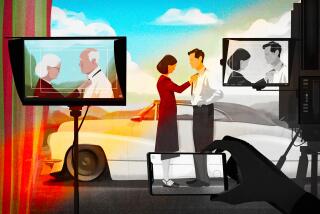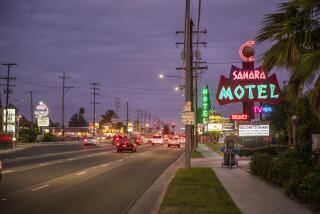Darkroom Still in Black in Color Age
Fifteen years may not seem like a long time for a business to exist in Laguna Beach. But for a rental darkroom on trendy Broadway, it is just short of a miracle.
Wally Jaynes, owner of the Darkroom, has lasted where others have failed.
The move toward one-hour color developing has been so strong recently that most labs no longer process black and white. However, Jaynes’ business has continued to grow stronger through the black-and-white market.
Besides renting out darkroom space, the Darkroom offers custom black-and-white processing, the printing of publicity and passport photos, copy work and sale of darkroom and film supplies. It takes in color-processing work but sends it to another lab.
“Laguna Beach itself has changed over the past 15 years,” said Jaynes, 52. “We had the tail end of the flower children coming in, and today a lot of those are wearing neckties and driving BMWs.
“They’ve gone from shooting pictures occasionally . . . to sporting cameras like the Minolta 9000 and buying film by the brick (20-roll pack). Instead of shooting love-ins, they’re shooting real estate.”
Jaynes’ first experience with photography came when he was working as a commercial diver, inspecting and repairing underwater pipelines.
His boss wanted him to shoot photos of the underwater equipment. He took a Nikonos (an underwater camera) down and came up a success.
At first he disliked shooting underwater. “It’s like anything else in life--when you don’t know what you’re doing or you’re unsure of it, you don’t like doing it,” said Jaynes, who developed proficiency through practice.
“The water was so dirty that we used ASA (film speed) from 1,600 to 12,000,” he said. “You just couldn’t light it up artificially--it would be like using your high beams in a fog bank.”
Often he had to process his film on the boat.
“I’ve processed film in everything, using bottled water and salt water,” he said. “I used salt water for stop bath and a wash.”
In early 1972, bored with his job as a diver, he took four classes at a local high school: art, stocks and bonds, creative writing and photography.
“I learned in the art class that it (art) would be something to do when I have more time,” Jaynes said. “In the stocks and bonds class I realized I had no business buying stocks and bonds. I loved the creative writing class, and the darkroom work is where I could ‘see the light.’ ”
Of the classes, the photography course was the most popular. “Some were in it for the sixth, seventh or eighth time,” he said, “not to learn more, but to have access to the lab. It was crowded, and they only had the class one night a week for two hours.”
So in 1973 Jaynes obtained $4,000, a one-year lease and decided to open a rental darkroom. A year later he moved across the street and has been there ever since.
Jaynes has noticed many changes over the years. In the beginning, his lab was used primarily by the hobbyist. Now more professionals and serious amateurs use it because they find it easier, cheaper and cleaner than setting up their own lab.
He has seen it all--thousands of photos of cats, dogs, birds, vacation scenes and children. Even photos of a Rolls-Royce when the Rajneesh temple was in full swing up in the Laguna Canyon.
“It’s fun to watch people develop (as photographers),” he said. “It ranges from students who are behind with their (photo) projects to housewives to professionals.”
The photography column, which runs each Saturday in Orange County Life, is designed to help both the serious amateur and weekend shooter. Questions and ideas are welcome and encouraged. Write to: Robert Lachman, chief photographer, The Times, 1375 Sunflower Ave., Costa Mesa, Calif. 92626.
More to Read
Sign up for Essential California
The most important California stories and recommendations in your inbox every morning.
You may occasionally receive promotional content from the Los Angeles Times.











